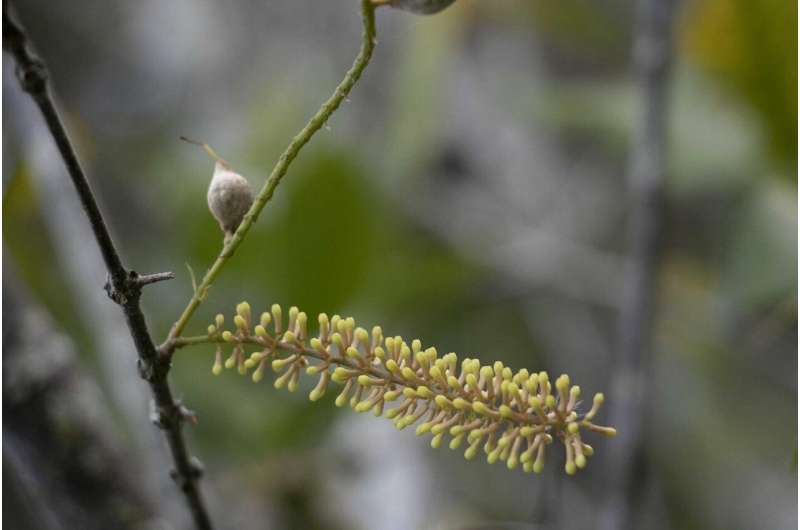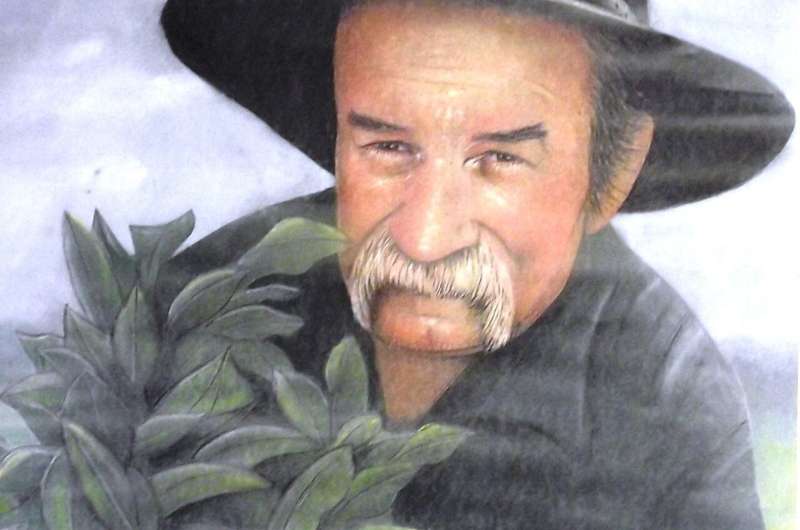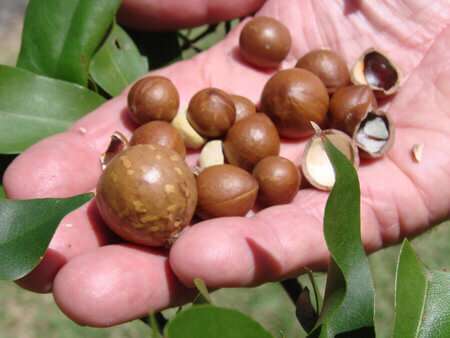The flower or raceme of the critically endangered Macadamia jansenii - one of four macadamia species that are native to Australia. Credit: Bruce Topp, University of Queensland
One of the world's rarest tree species has been transformed into a sophisticated model that University of Queensland researchers say is the future of plant research.
"Macadamia jansenii is a critically endangered species of macadamia which was only described as a new species in 1991," said Robert Henry, Professor of Innovation at the Queensland Alliance for Agriculture and Food Innovation (QAAFI).
"It grows near Miriam Vale in Queensland and there are only around 100 known trees in existence."
However, with funding from Hort Innovation's Tree Genomics project, and UQ's Genome Innovation Hub Macadamia jansenii has now become the world's most sophisticated plant research model.
Professor Henry said Macadamia jansenii was probably the best studied species on the planet in terms of its genetics.
"Macadamia jansenii has potentially become the model for assembling all future plant genomes," he said.
Professor Henry said the entire jansenii species grows in one small area. "This means we have the potential to study the diversity of the whole species," he said.
"This is unusual, even for rare or endangered plants—it means we can get a lot of information about how rare plant species survive the impact of small population size and the associated genetic bottleneck.
Portrait of Central Queensland farmer and skilled amateur botanist Ray Jansen, who discovered the critically endangered Macadamia jansenii species in 1983. Mr Jansen died before the species formally described as a new species in 1991. The artist is unknown. Credit: Ray Jansen portrait painting_artist unkown_Photo Ian McConachie
Professor Henry said that particular characteristics of Macadamia jansenii made it useful for improving the technology and methodology for sequencing and assembling plant genomes.
"We investigated the different sequencing technologies, all the different software and algorithms that you can use in genomic sequencing, and then applied each of them to the same sample to find out what worked best," he said.
"It's a long, complex and very expensive process, so we wanted to use the latest technology to improve its efficiency."
The Genome Innovation Hub's Ms Valentine Murigneux analyzed the genome sequence and QAAFI researchers then assembled all 14 chromosomes for the species, in collaboration with laboratories in the United States. This work was published in GigaScience.
Professor Henry said the work is of great interest globally.
"High quality genome sequences are proving much more useful than rough draft sequences with less errors and better outcomes for plant breeding," he said.
Macadamia jansenii was first brought to the attention of Western plant scientists in 1983, by Ray Jansen, a canefarmer and skilled amateur botanist from a South Kolan in Central Queensland.
Ms Denise Bond, Executive Officer of the Macadamia Conservation Trust said since 2018 about 60 new mature Macadamia jansenii trees have been located, although a quarter of these were destroyed in the bush fires of 2019.
Different nut sizes from Nuts from Macadamia integrifolia and M. jansenii. Credit: Scott Lamond
"We very much welcome the genomic research on Macadamia jansenii as it will help prioritize future conservation efforts, although right now the most critical thing is to protect the remaining wild trees in their original habitat," Ms Bond said.
She said the remaining three macadamias species - M. ternifolia, M. tetraphylla and M. integrifola—were listed on the International Union for Conservation of Nature's Red List of Threatened Species in 2020.
"This is a wake-up call to Australia to take better care of our native macadamia species."
Professor Henry said all four macadamia species—tetraphylla, integrifolia, ternifolia and jansenii have now undergone the same analysis.
"It is fitting this work has been developed in Queensland using the Macadamia genus—one of Australia's few additions to the world's food crops," he said
The macadamia genomic work forms part of a five-year project to develop detailed high quality genome sequencing for five of Australia's key horticultural tree crops—avocado, macadamia, mango, citrus and almond—which account for 80 percent of Australian horticulture tree crop value.
"The macadamia data we have generated has been fed through to a range of projects including research on sustainably intensifying tree crop production and breeding for key commercial attributes in macadamia production," Professor Henry said.
More information: Valentine Murigneux et al, Comparison of long-read methods for sequencing and assembly of a plant genome, GigaScience (2020). DOI: 10.1093/gigascience/giaa146
Journal information: GigaScience
Provided by University of Queensland


























